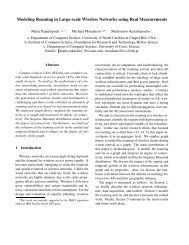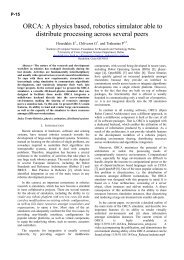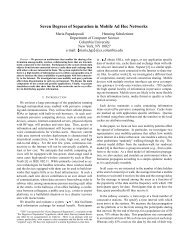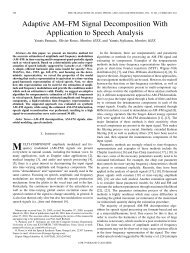Master Thesis - ICS
Master Thesis - ICS
Master Thesis - ICS
You also want an ePaper? Increase the reach of your titles
YUMPU automatically turns print PDFs into web optimized ePapers that Google loves.
Computer Science Department<br />
Antonis Misargopoulos<br />
emerging in industry, science, and engineering. This sharing is, necessarily, highly<br />
controlled, with resource providers and consumers defining clearly and carefully just<br />
what is shared, who is allowed to share, and the conditions under which sharing occurs.<br />
A set of individuals and/or institutions defined by such sharing rules form what we call a<br />
virtual organization.”<br />
2.2 Virtual Organizations<br />
Nowadays, it is clearly that computational Grids and peer-to-peer (P2P) computing<br />
systems are emerging as a new paradigm for solving large-scale problems in science,<br />
engineering and commerce. They enable the creation of virtual enterprises (VEs) or<br />
virtual organizations (VOs) for sharing and aggregation of numerous resources<br />
geographically distributed across organizations and administrative domains. They<br />
comprise:<br />
• heterogeneous resources (such as PCs, workstations, clusters and supercomputers),<br />
• management systems (such as single system image OS, queuing systems), supporting<br />
• different kind of applications (such as scientific, engineering and commercial), and<br />
demanding<br />
• various requirements (for CPU, I/O, memory and/or network intensive).<br />
The producers (resource owners) and consumers (resource users) most of the time<br />
have different goals, objectives, strategies and supply-and-demand patterns. More<br />
importantly, both resources and end-users are geographically distributed with different<br />
time zones. In managing such complex environments, traditional approaches to resource<br />
management that attempt to optimize system-wide measure of performance cannot be<br />
employed. Traditional approaches use centralized policies that need complete state<br />
information and a common management policy, or a decentralized consensus-based<br />
policy. Due to the complexity in constructing successful Grid-aware environments, it is<br />
impossible to define an acceptable system-wide performance matrix and common fabric<br />
management policy.<br />
The main problem that underlies the Grid concept is coordinated resource sharing<br />
and problem solving in dynamic, multi-institutional virtual organizations. The sharing<br />
6

















